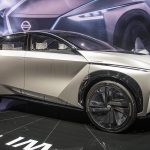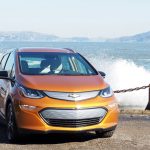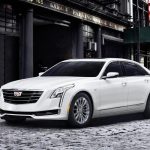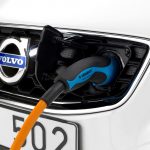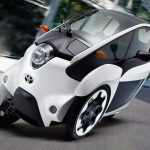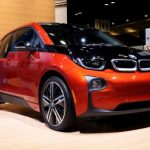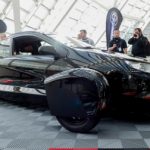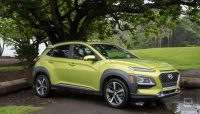Why Mercedes’s Self-Driving Car Is So Much More Tempting Than Google’s
Mercedes-Benz just dreamed up the first tempting self-driving car. And in the process, they show us all what Google was missing.
A man pulls his cellphone out of his pocket and hits a button. A glowing vehicle pulls up that looks like it was carved from a single block of silver. The door opens automatically, and the empty seat turns its driver, beckoning him with a tacit “get in.” Who could resist?

This is the first extended look at the Mercedes-Benz F015 Luxury in Motion concept vehicle, which debuted this week at the Consumer Electronics Show. As the driverless car market races toward actualization, we’ve seen what Google imagines a vehicle can be when a driver is no longer tethered to a steering wheel—and that was more or less a Volkswagen Beetle crossed with a Smartcar—a wussy, small footprint vehicle optimized for middle-class urban living, buffed with innocuous edges of a Fisher Price toy, as if to tell people on the crosswalk and bill signers in Washington, “It’s OK, I won’t murder you.” And in that regard, the car succeeds in its design. But who wants to buy a nerdmobile with no wheel?
Enter Mercedes-Benz, with over a century of experience in making cars that people want to drive. Their vision—which to be fair, is undeniably more premium than Google’s—imagines the driverless car, not just a means to get from point A to B without dying, but as the next logical step in luxury vehicles: It’s Bruce Wayne’s ride for those days Alfred has off—a car that caters to your needs, communicates its intentions, and offers control when you want to feel like a superhero.
Google is designing to appease regulators, while Mercedes is designing to appeal to people.
The F015’s saloon-style doors open into one big car room that’s been decorated like a Scandinavian nightclub. The four seats can face forward like a normal car, or they can turn to face one another, allowing you to socialize. To complete the effect, designers have traded carpet for hardwood flooring. Around the car’s trim, a Mercedes-Benz plaque greets you like a welcome mat.
Touchscreen displays run along the interior edges. They allow you to plot your course, or pull up information of places you might visit on your journey. But the car’s exterior communicates information as well. A front and rear LED matrix can display messages, like “SLOW,” to other drivers on the road, much like brake lights work today. And for pedestrians nervous to step in front of a car without a driver, Mercedes didn’t choose to make their car look friendly like Google. Instead, they mounted a laser projector in the car’s grill, which projects a crosswalk telling a pedestrian they are safe to pass.
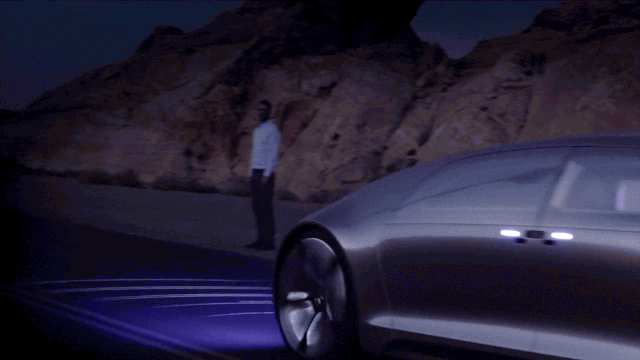
Indeed, Mercedes has used small details like these to construct a language of between humans and robots, making their F015 something more than a silent ferry that takes you from place to place in the most algorithmically efficient way possible, and more a steerable ship that will tune itself to your tastes for your next adventure. Even though this club on wheels is perfectly capable of driving itself, the F015 gives drivers the option to drive. Within the controls, the company has also tucked away a slider that pulls the computer driver between relaxed and dynamic modes—a small touch that recognizes a passenger’s need for control over an autonomous system hurling them 70mph over the asphalt, even if that control is severely limited.
And maybe most importantly, the car still has a steering wheel—a steering wheel that Google has castrated in their robotic eunuch. I’m sure that in another 20 years, very few of us will be driving during rush hour, and opt to sit back and play Angry Birds XXI instead. But for the foreseeable future, a car should still offer its driver the option to drive it—and the fancy robots can brake and steer assist to make sure that a new fleet of under-experienced human drivers don’t kill themselves doing so.
Google’s car is a technological wonder that conservatively assures us a message of “safety first,” but little about its design signifies that it wants or needs a human inside. As Chris Urmson, the director of the Google’s car put it recently: “On the inside, we’ve designed for learning, not luxury, so we’re light on creature comforts, but we’ll have two seats (with seatbelts), a space for passengers’ belongings, buttons to start and stop, and a screen that shows the route—and that’s about it.” In contrast, the F015, while only a concept, teases a future of driving in which we’ll want to spend six figures on a vehicle we may never drive, in which automation doesn’t need to be mere utility, and approachability doesn’t need to equate to riding in a big baby’s toy.
[H/T: designboom]
A man pulls his cellphone out of his pocket and hits a button. A glowing vehicle pulls up that looks like it was carved from a single block of silver. The door opens automatically, and the empty seat turns its driver, beckoning him with a tacit “get in.” Who could resist?

This is the first extended look at the Mercedes-Benz F015 Luxury in Motion concept vehicle, which debuted this week at the Consumer Electronics Show. As the driverless car market races toward actualization, we’ve seen what Google imagines a vehicle can be when a driver is no longer tethered to a steering wheel—and that was more or less a Volkswagen Beetle crossed with a Smartcar—a wussy, small footprint vehicle optimized for middle-class urban living, buffed with innocuous edges of a Fisher Price toy, as if to tell people on the crosswalk and bill signers in Washington, “It’s OK, I won’t murder you.” And in that regard, the car succeeds in its design. But who wants to buy a nerdmobile with no wheel?
Enter Mercedes-Benz, with over a century of experience in making cars that people want to drive. Their vision—which to be fair, is undeniably more premium than Google’s—imagines the driverless car, not just a means to get from point A to B without dying, but as the next logical step in luxury vehicles: It’s Bruce Wayne’s ride for those days Alfred has off—a car that caters to your needs, communicates its intentions, and offers control when you want to feel like a superhero.
Google is designing to appease regulators, while Mercedes is designing to appeal to people.
The F015’s saloon-style doors open into one big car room that’s been decorated like a Scandinavian nightclub. The four seats can face forward like a normal car, or they can turn to face one another, allowing you to socialize. To complete the effect, designers have traded carpet for hardwood flooring. Around the car’s trim, a Mercedes-Benz plaque greets you like a welcome mat.
Touchscreen displays run along the interior edges. They allow you to plot your course, or pull up information of places you might visit on your journey. But the car’s exterior communicates information as well. A front and rear LED matrix can display messages, like “SLOW,” to other drivers on the road, much like brake lights work today. And for pedestrians nervous to step in front of a car without a driver, Mercedes didn’t choose to make their car look friendly like Google. Instead, they mounted a laser projector in the car’s grill, which projects a crosswalk telling a pedestrian they are safe to pass.

Indeed, Mercedes has used small details like these to construct a language of between humans and robots, making their F015 something more than a silent ferry that takes you from place to place in the most algorithmically efficient way possible, and more a steerable ship that will tune itself to your tastes for your next adventure. Even though this club on wheels is perfectly capable of driving itself, the F015 gives drivers the option to drive. Within the controls, the company has also tucked away a slider that pulls the computer driver between relaxed and dynamic modes—a small touch that recognizes a passenger’s need for control over an autonomous system hurling them 70mph over the asphalt, even if that control is severely limited.
And maybe most importantly, the car still has a steering wheel—a steering wheel that Google has castrated in their robotic eunuch. I’m sure that in another 20 years, very few of us will be driving during rush hour, and opt to sit back and play Angry Birds XXI instead. But for the foreseeable future, a car should still offer its driver the option to drive it—and the fancy robots can brake and steer assist to make sure that a new fleet of under-experienced human drivers don’t kill themselves doing so.
Google’s car is a technological wonder that conservatively assures us a message of “safety first,” but little about its design signifies that it wants or needs a human inside. As Chris Urmson, the director of the Google’s car put it recently: “On the inside, we’ve designed for learning, not luxury, so we’re light on creature comforts, but we’ll have two seats (with seatbelts), a space for passengers’ belongings, buttons to start and stop, and a screen that shows the route—and that’s about it.” In contrast, the F015, while only a concept, teases a future of driving in which we’ll want to spend six figures on a vehicle we may never drive, in which automation doesn’t need to be mere utility, and approachability doesn’t need to equate to riding in a big baby’s toy.
[H/T: designboom]
[All images: via Mercedes]
(154)



